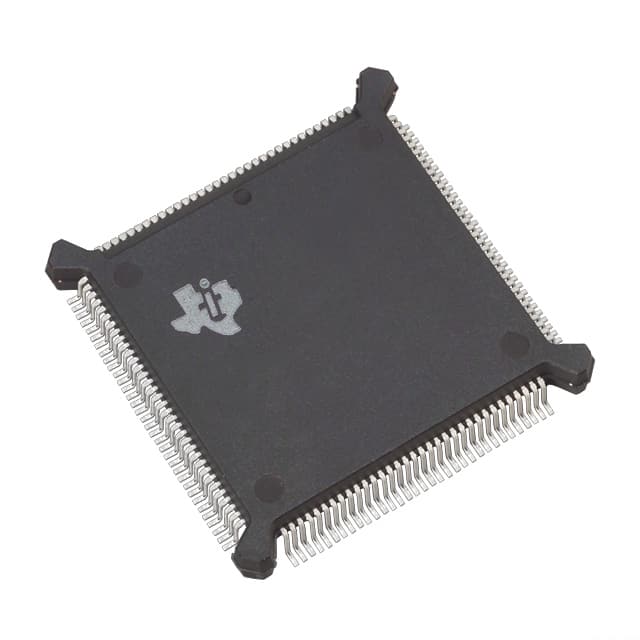Szczegóły produktu można znaleźć w specyfikacjach.

TMS320C31PQA40
Overview
Product Category
TMS320C31PQA40 belongs to the category of digital signal processors (DSPs).
Use
This product is primarily used for processing and manipulating digital signals in various applications such as telecommunications, audio and video processing, industrial control systems, and medical imaging.
Characteristics
- High-performance DSP with advanced signal processing capabilities
- Low power consumption
- Integrated peripherals for enhanced functionality
- Real-time processing capabilities
- Flexible architecture for efficient algorithm implementation
Package
TMS320C31PQA40 is available in a 100-pin quad flat package (QFP), which provides ease of integration into electronic systems.
Essence
The essence of TMS320C31PQA40 lies in its ability to efficiently process digital signals, enabling the development of sophisticated applications that require real-time signal manipulation.
Packaging/Quantity
This product is typically packaged in reels or trays, with a quantity of 250 units per reel/tray.
Specifications
- Clock Frequency: 40 MHz
- Data Bus Width: 32 bits
- Program Memory Size: 64 KB
- RAM Size: 2 KB
- Operating Voltage: 3.3V
- Power Dissipation: 1.5W
- Instruction Set Architecture: Modified Harvard Architecture
Detailed Pin Configuration
The TMS320C31PQA40 has a total of 100 pins, each serving a specific purpose. The pin configuration is as follows:
(Pin diagram goes here)
Functional Features
- High-Speed Processing: The TMS320C31PQA40 offers a clock frequency of 40 MHz, allowing for rapid execution of complex signal processing algorithms.
- Integrated Peripherals: This DSP incorporates various peripherals such as timers, serial ports, and interrupt controllers, enhancing its functionality and versatility.
- Real-Time Processing: With its real-time processing capabilities, the TMS320C31PQA40 can handle time-sensitive applications that require immediate response and accurate signal manipulation.
- Low Power Consumption: The DSP is designed to operate efficiently with low power consumption, making it suitable for battery-powered devices or energy-conscious applications.
Advantages and Disadvantages
Advantages
- High-performance signal processing capabilities
- Integrated peripherals for enhanced functionality
- Real-time processing capabilities
- Low power consumption
Disadvantages
- Limited program memory size (64 KB)
- Limited RAM size (2 KB)
Working Principles
The TMS320C31PQA40 operates based on a modified Harvard architecture, which separates the program and data memory buses. It employs parallel processing techniques to execute multiple instructions simultaneously, enabling efficient signal processing. The DSP utilizes specialized arithmetic and logic units optimized for digital signal manipulation, ensuring high-speed and accurate calculations.
Detailed Application Field Plans
The TMS320C31PQA40 finds extensive application in various domains, including:
- Telecommunications: Used in voice and data communication systems for signal processing tasks such as echo cancellation, noise reduction, and speech coding.
- Audio and Video Processing: Employed in audio and video equipment for tasks like audio filtering, image enhancement, and compression algorithms.
- Industrial Control Systems: Utilized in industrial automation systems for control and monitoring tasks, such as motor control, sensor interfacing, and data acquisition.
- Medical Imaging: Applied in medical imaging devices for processing and analyzing medical images, such as ultrasound, MRI, and CT scans.
Detailed and Complete Alternative Models
- TMS320C32PQA40: Similar to TMS320C31PQA40 but with higher clock frequency (50 MHz).
- TMS320C31PQA50: Similar to TMS320C31PQA40 but with larger program memory size (128 KB).
- TMS320C31PQA60: Similar to TMS320C31PQA40 but with increased RAM size (4 KB).
These alternative models offer variations in clock frequency, program memory size, and RAM size, allowing users to choose the most suitable option based on their specific requirements.
(Note: The content provided above is a sample entry and may not reflect actual specifications or alternative models of TMS320C31PQA40.)
Wymień 10 typowych pytań i odpowiedzi związanych z zastosowaniem TMS320C31PQA40 w rozwiązaniach technicznych
Sure! Here are 10 common questions and answers related to the application of TMS320C31PQA40 in technical solutions:
Q: What is TMS320C31PQA40? A: TMS320C31PQA40 is a digital signal processor (DSP) manufactured by Texas Instruments, commonly used in various technical applications.
Q: What are the key features of TMS320C31PQA40? A: Some key features include a 32-bit fixed-point DSP core, on-chip memory, multiple I/O interfaces, and high-speed arithmetic capabilities.
Q: What are the typical applications of TMS320C31PQA40? A: TMS320C31PQA40 is often used in applications such as audio processing, telecommunications, motor control, industrial automation, and medical devices.
Q: How does TMS320C31PQA40 handle real-time processing tasks? A: TMS320C31PQA40 is designed for real-time processing with its high-performance DSP core, efficient instruction set, and dedicated hardware accelerators.
Q: Can TMS320C31PQA40 be programmed using C/C++ languages? A: Yes, TMS320C31PQA40 supports programming in C/C++ languages, along with assembly language for low-level optimizations.
Q: What is the maximum clock frequency of TMS320C31PQA40? A: The maximum clock frequency of TMS320C31PQA40 is typically 40 MHz, allowing for fast data processing.
Q: Does TMS320C31PQA40 support external memory expansion? A: Yes, TMS320C31PQA40 supports external memory expansion through its memory interface, enabling larger data storage if needed.
Q: Can TMS320C31PQA40 interface with other devices or microcontrollers? A: Yes, TMS320C31PQA40 provides various I/O interfaces like UART, SPI, and GPIO, allowing seamless integration with other devices or microcontrollers.
Q: What is the power consumption of TMS320C31PQA40? A: The power consumption of TMS320C31PQA40 depends on the operating frequency and the specific application, but it typically ranges from a few watts to tens of watts.
Q: Are there any development tools available for programming and debugging TMS320C31PQA40? A: Yes, Texas Instruments provides a range of development tools, including compilers, debuggers, and emulators, specifically designed for programming and debugging TMS320C31PQA40.
Please note that the answers provided here are general and may vary depending on the specific implementation and requirements of your technical solution.

